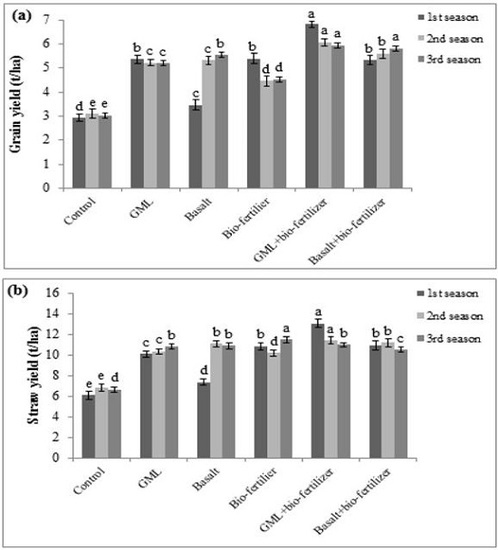Applying Limestone or Basalt in Combination with Bio-Fertilizer to Sustain Rice Production on an Acid Sulfate Soil in Malaysia
Abstract
:1. Introduction
2. Experimental Section
2.1. Experimental Site
2.2. Experimental Design
2.2.1. Biochemical Properties of the Basalt, Ground Magnesium Limestone (GML) and Bio-Fertilizer
2.2.2. Rice Seedlings and Transplanting
2.3. Soil and Plant Analysis
2.4. Determination of Yield Parameters and Nutrient Concentration in Plant
2.5. Determination of Aluminum Form in the Soil
2.6. Average Weather Conditions at the Study Site
2.7. Statistical Analysis
3. Results
3.1. Initial Chemical Properties of the Soil
3.2. Effects of Applying Amendments on Soil pH
3.3. Effects of Treatments on Plant Nutrients
3.4. Effects of Treatments on Chlorophyll Content
3.5. Effects of Treatments on Plant Height, Root Length, and Tiller Number
3.6. Effects of Treatments on Panicle Number, Panicle Size, Unfilled Grain and Harvest Index
3.7. Effects of Treatments on Rice Yield
3.8. Effects of Treatments on Nitrogen, Phosphorus, Potash (NPK) and Protein Content in the Tissue or Grain
3.9. Effects of Treatments on Al, Fe, Ca, Mg, and Si Content in the Plant Tissue
3.10. Effects of Treatments on Al Form in Soil
3.11. Relationship between pH with Ca, Mg, Al, and Fe
4. Discussion
4.1. Effects of Applying GML on Soil Properties
4.2 Effects of Basalt Application on Soil Properties
4.3. Effects of Applying Bio-Fertilizer on Soil
4.4. Residual Effects of GML and Basalt Application on Nutrients
4.5. Residual Effects of GML, Basalt with or without Bio-Fertilizer Application on Rice Growth
5. Conclusions
Acknowledgments
Author Contributions
Conflicts of Interest
References
- Enio, M.S.K.; Shamshuddin, J.; Fauziah, C.I.; Husni, M.H.A. Pyritization of the Coastal Sediments in the Kelantan Plains in the Malay Peninsula during the Holocene. Am. J. Agric. Biol. Sci. 2011, 6, 393–402. [Google Scholar] [CrossRef]
- Shamshuddin, J.; Muhrizal, S.; Fauziah, I.; Husni, M.A.H. Effects of adding organic materials to an acid sulfate soil on the growth of cocoa (Theobroma cacao L.) seedlings. Sci. Total Environ. 2004, 323, 33–45. [Google Scholar] [CrossRef] [PubMed]
- Shamshuddin, J.; Elisa, A.; Shazana, M.A.R.S.; Fauziah, C.I.; Panhwar, Q.A.; Naher, U.A. Properties and Management of Acid Sulfate Soils in Southeast Asia for Sustainable Cultivation. Adv. Agron. 2014, 124, 91–142. [Google Scholar]
- Kochian, L.V. Cellular Mechanisms of Aluminum Toxicity and Resistance in Plants. Ann. Rev. Plant Physiol. Plant Mol. Biol. 1995, 46, 237–260. [Google Scholar] [CrossRef]
- Shamshuddin, J. Acid Sulfate Soils in Malaysia; UPM Press: Serdang, Malaysia, 2006. [Google Scholar]
- Park, Y.D.; Kim, Y.S. The effect of wollatonite and manganese dioxide on rice grown on a flooded acid sulphate soil. J. Korean Soc. Soil Sci. Fertil. 1970, 3, 23–28. [Google Scholar]
- Shazana, M.A.R.S.; Shamshuddin, J.; Fauziah, C.I.; Syed Omar, S.R. Alleviating the infertility of an acid sulphate soil by using ground basalt with or without lime and organic fertilizer under submerged condition. Land Degrad. Dev. 2013, 24, 129–140. [Google Scholar] [CrossRef]
- Panhwar, Q.; Naher, U.A.; Radziah, O.; Shamshuddin, J.; Razi Mohd, I. Bio-Fertilizer, Ground Magnesium Limestone and Basalt Applications May Improve Chemical Properties of Malaysian Acid Sulfate Soils and Rice Growth. Pedosphere 2014, 24, 827–835. [Google Scholar] [CrossRef]
- Panhwar, Q.; Naher, U.A.; Shamshuddin, J.; Radziah, O.; Latif, M.; Mohd Razi, I. Biochemical and Molecular Characterization of Potential Phosphate-Solubilizing Bacteria in Acid Sulfate Soils and Their Beneficial Effects on Rice Growth. PLoS ONE 2014, 9, e97241. [Google Scholar] [CrossRef] [PubMed]
- Muhrizal, S.; Shamshuddin, J.; Husni, M.A.H.; Fauziah, I. Alleviation of aluminum toxicity in an acid sulfate soil in Malaysia using organic materials. Commun. Soil Sci. Plant Anal. 2003, 34, 2993–3012. [Google Scholar] [CrossRef]
- Muhrizal, S.; Shamshuddin, J.; Fauziah, I.; Husni, M.A.H. Changes in iron-poor acid sulfate soil upon submergence. Geoderma 2006, 131, 110–122. [Google Scholar] [CrossRef]
- Tran, K.T.; Vo, T.G. Effects of mixed organic and inorganic fertilizers on rice yield and soil chemistry of the 8th crop on heavy acid sulfate soil (Hydraquentic Sulfaquepts) in the Mekong Delta of Vietnam. In Presented at the 6th International Symposium on Plant-Soil at Low pH, Sendai, Japan, 1–5 August 2004.
- Amin, M.A.; Uddin, M.A.; Hossain, M.A. Regeneration study of some Indica rice cultivars followed by Agrobacterium-Mediated transformation of highly regenerable cultivar BR-8. J Biol. Sci. 2004, 4, 207–211. [Google Scholar]
- Benton, J., Jr. Laboratory Guide for Conducting Soil Tests and Plant Analysis; CRC LLC Press: New York, NY, USA, 2001. [Google Scholar]
- Bremner, J.M.; Mulvaney, C.S. Nitrogen-total. In Methods of Soil Analysis. Part 2: Chemical and Microbiological Properties, Agronomy No. 9, 2nd ed.; Page, A.L., Miller, R.H., Eds.; ASA and SSSA: Madison, WI, USA, 1982; pp. 595–624. [Google Scholar]
- Bray, R.; Kurtz, L.T. Determination of total, organic, and available forms of phosphorus in soils. Soil Sci. 1945, 59, 39–46. [Google Scholar] [CrossRef]
- Havlin, J.L.; Soltanpour, P.N. A nitric acid plant tissue digest method for use with inductively coupled plasma spectrometry. Commun. Soil Sci. Plant Anal. 1980, 11, 969–980. [Google Scholar] [CrossRef]
- Bottini, N.; Musumeci, L.; Alonso, A.; Rahmouni, S.; Nika, K.; Rostamkhani, M.; Mustelin, T. A functional variant of lymphoid tyrosine phosphatase is associated with type I diabetes. Nat. Genet. 2004, 36, 337–338. [Google Scholar] [CrossRef] [PubMed]
- Kotzé, W.A.G.; Joubert, M.; de Villiers, J.F.; van der Westhuizen, M.; van der Bank, D. Measurement of exchangeable aluminium in soils and clay minerals by isotopic exchange. S. Afr. J. Plant Soil. 1984, 1, 57–60. [Google Scholar] [CrossRef]
- Kitsopoulos, K.P. Materials: Applicability of the Ammonium Acetate. Clays Clay Miner. 1999, 47, 688–696. [Google Scholar] [CrossRef]
- Seizo, M. Easy diagnosis of rice cultivation. In Rice Cultivation for the Million; Japan Scientific Societies Press: Tokyo, Japan, 1980; pp. 30–31. [Google Scholar]
- Dobermann, A.; Fairhurst, T. Rice: Nutrient Disorders & Nutrient Management; International Rice Research Institute: Los Benos, Philippines, 2000; Volume 1. [Google Scholar]
- Ryan, J.; Estefen, G.; Rashid, A. Soil and Plant Analysis Laboratory Manual., 2nd ed.; ICARDA Press: Aleppo, Syria, 2001. [Google Scholar]
- Drabek, O.; Boruvka, L.; Mladkova, L.; Kocarek, M. Possible method of aluminium speciation in forest soil. J. Inorg. Biochem. 2003, 97, 8–15. [Google Scholar] [CrossRef]
- Malaysian Meteorological Department. Available online: http://www.met.gov.my/ (accessed on 13 November 2014).
- SAS Software, version 9.3; SAS Institute: Cary, NC, USA.
- Soil Survey Staff. Keys to Soil Taxonomy; United States Department of Agriculture: Washington, DC, USA, 2014. [Google Scholar]
- De Coninck, F. Physico-Chemical Aspects of Pedogenesis; International Training for Post-Graduate Soil Scientists, Ghent University: Ghent, Belgium, 1978. [Google Scholar]
- Alia, F.; Shamshuddin, J.; Fauziah, C.; Ahmad Husni, M.; Panhwar, Q. Effects of Aluminum, Iron and/or Low pH on Rice Seedlings Grown in Solution Culture. Int. J. Agric. Biol. 2015, 17, 702–710. [Google Scholar] [CrossRef]
- Anda, M.; Shamshuddin, J.; Fauziah, C.I. Improving the chemical properties of a highly weathered soil using finely ground basalt rocks. Catena 2015, 24, 147–161. [Google Scholar] [CrossRef]
- Bokhtiar, S.M.; Hai-Rong, H.; Yang-Rui, L.; Delvi, V.A. Effect of silicon on yield contributing parameters and its accumulation in abaxial epidermis of sugarcane leaf blades using energy dispersive X-ray analysis. In Proceedings of the International Conference on “Balanced Nutrient Management for Tropical Agriculture”, Kuantan, Malaysia, 12–16 April 2010; Wan, R., Che Fauziah, I., Roseazlin, A., Shamshuddin, J., Rosenani, A., Zaharah, A.R., Eds.; UPM Press: Serdang, Malaysia, 2010; pp. 170–173. [Google Scholar]
- Abed-Ashtiani, F.; Kadir, J.; Selamat, A.; Hanif, A.H.B. Effect of Foliar and Root Application of Silicon Against Rice Blast Fungus in MR219 Rice Variety. Plant Pathol. J. 2012, 28, 164–171. [Google Scholar] [CrossRef]
- Massey, F.P.; Hartley, S.E. Experimental demonstration of the antiherbi-vore effects of silica in grasses: Impacts on foliage digestibility and vole growth rates. Proc. R. Soc. B 2006, 273, 2299–2304. [Google Scholar] [CrossRef] [PubMed]
- Dent, D.L. Acid Sulfate Soils: A Baseline for Research and Development; ILRI Publication 39; International Institute for Land Reclamation and Improvement: Wageningen, The Netherlands, 1982. [Google Scholar]
- Alva, A.K.; Asher, C.J.; Edwards, D.G. The role of calcium in alleviating aluminum toxicity. Aust. J. Soil Res. 1986, 37, 375–383. [Google Scholar] [CrossRef]
- Shamshuddin, J.; Ismail, H. Reactions of ground magnesium limestone and gypsum in soil soils with variable-charge minerals. Soil Sci. Soc. Am. J. 1995, 59, 106–112. [Google Scholar] [CrossRef]
- Sahibin, A.; Wan Mohd, R.; Zulfahmi, A.; Tukimat, L.; Naqirah, N.; Abdul, S. Some Properties of Ultrabasic Soil from Bukit Tambun, Kelantan Barat, Kelantan. In Proceedings of the National Geoscience Conference, Kota Bharu, Malaysia, 31 July–1 August 2015; Taib, Nur Iskandar, Ed.; UMK Press: Kota Bharu, Malaysia, 2015; pp. 212–214. [Google Scholar]
- Panhwar, Q.; Naher, U.A.; Radziah, O.; Shamshuddin, J.; Mohd Razi, I.; Dipti, S.; Karabalei Aghamolki, M. Quality and antioxidant activity of rice grown on alluvial soil amended with Zn, Cu and Mo. S. Afr. J. Bot. 2015, 98, 77–83. [Google Scholar] [CrossRef]
- Naher, U.A.; Radziah, O.; Shamsuddin, Z.H.; Halimi, M.S.; Mohd Razi, I. Isolation of diazotrophs from different soils of Tanjong Karang Rice growing area in Malaysia. Int. J. Agri. Biol. 2009, 11, 547–552. [Google Scholar]
- Panhwar, Q.; Radziah, O.; Zaharah, A.; Sariah, M. Isolation and characterization of phosphate-solubilizing bacteria from aerobic rice. Afr. J. Biotechnol. 2012, 11, 2711–2719. [Google Scholar]
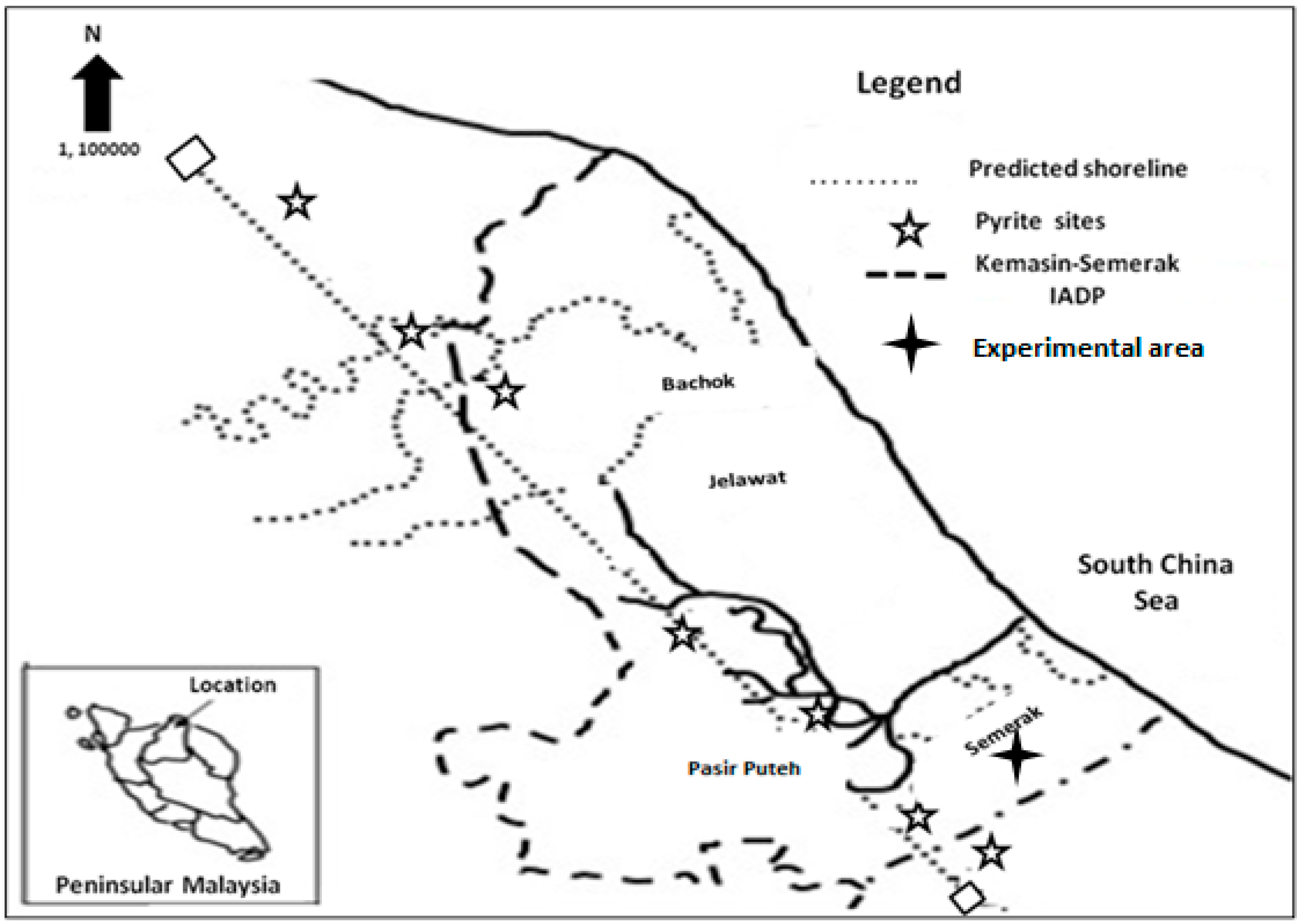
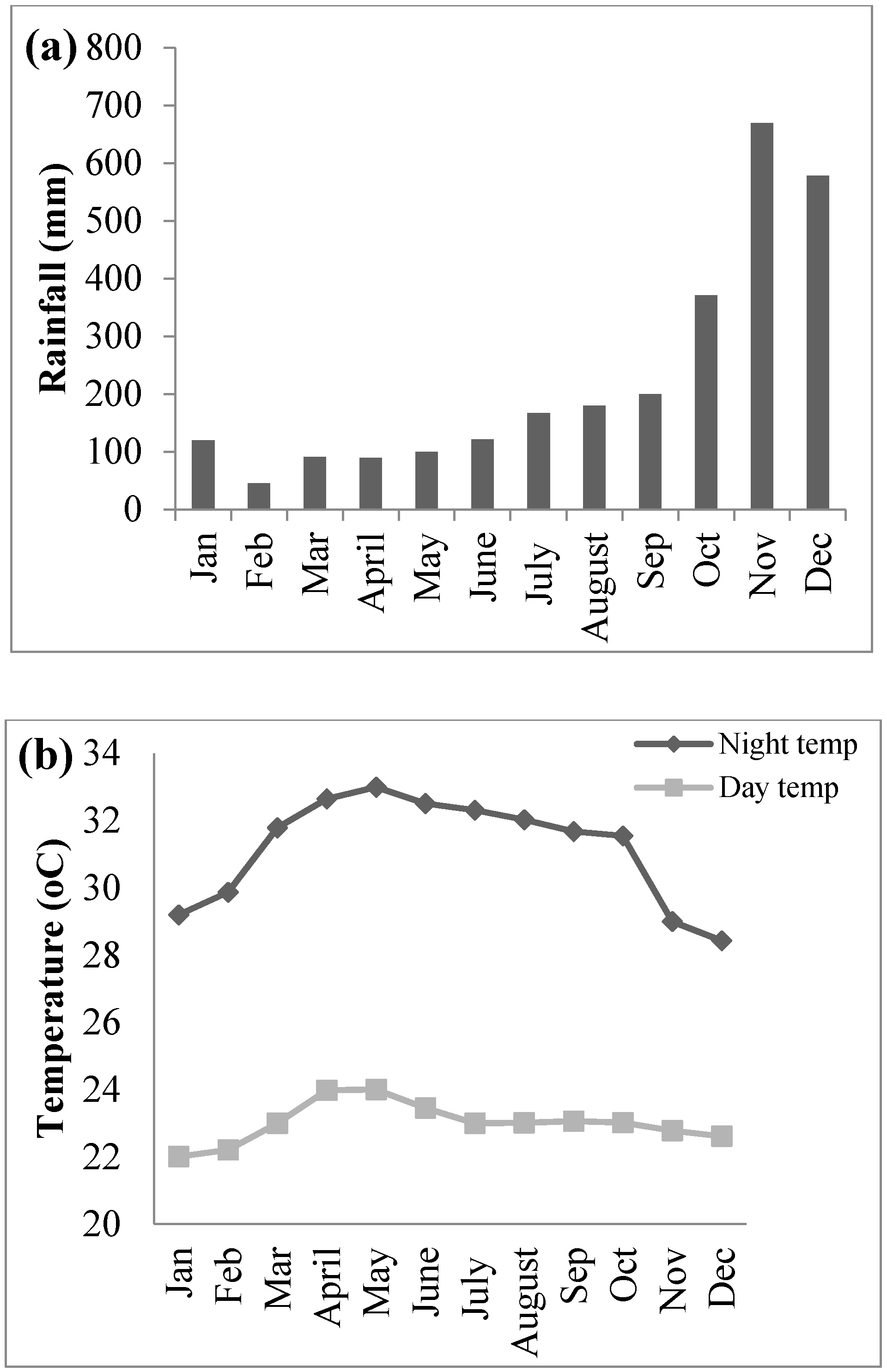
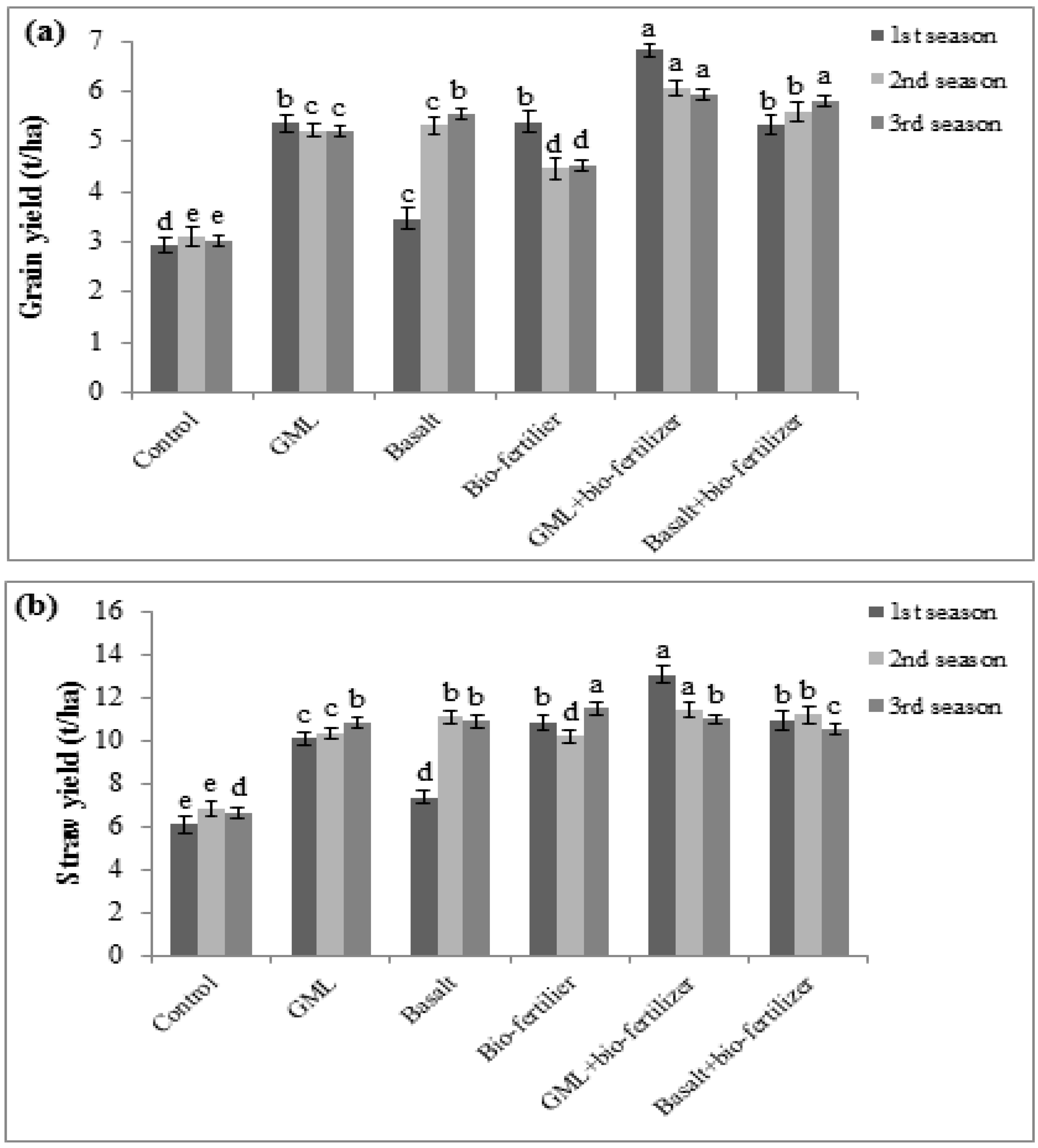

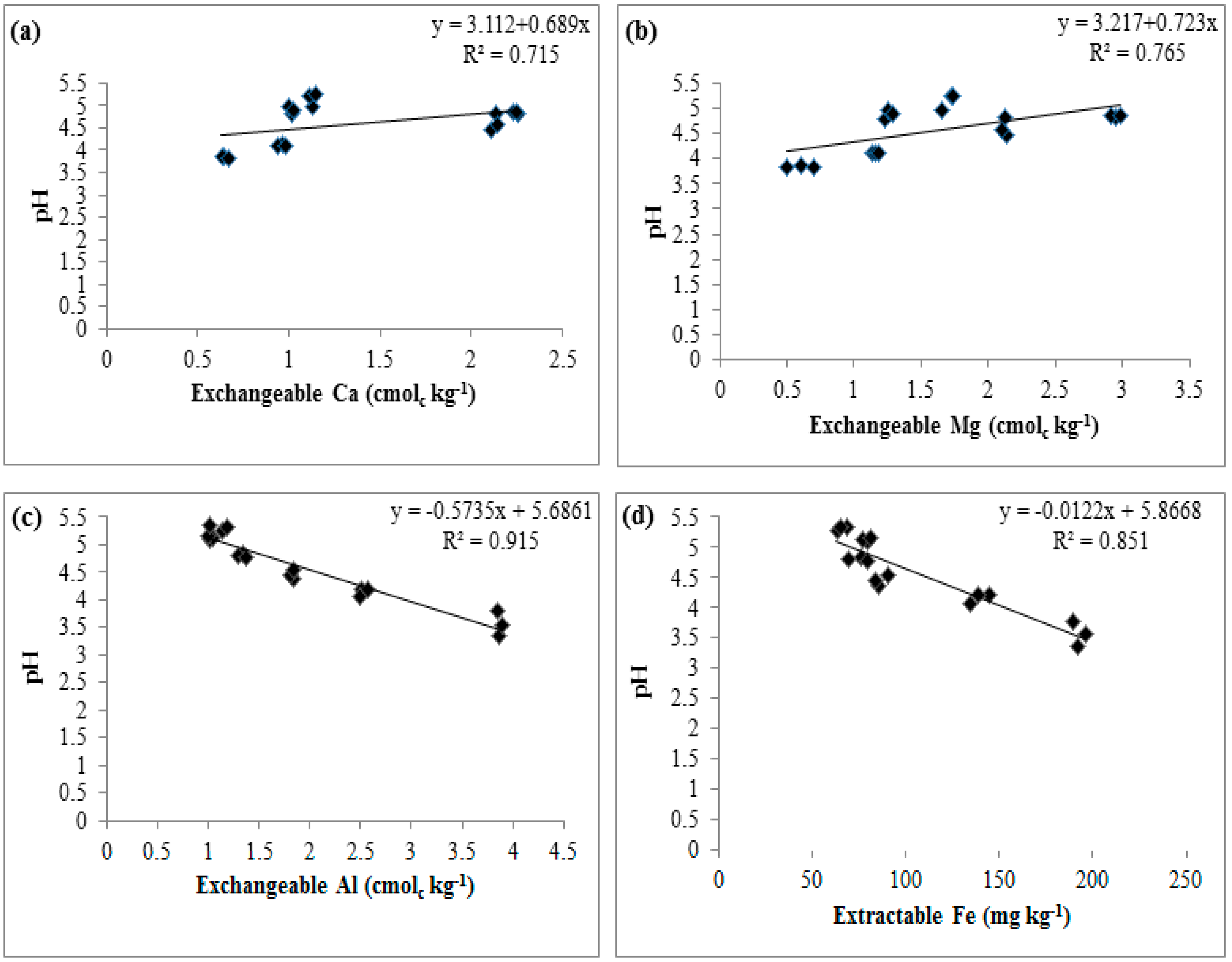
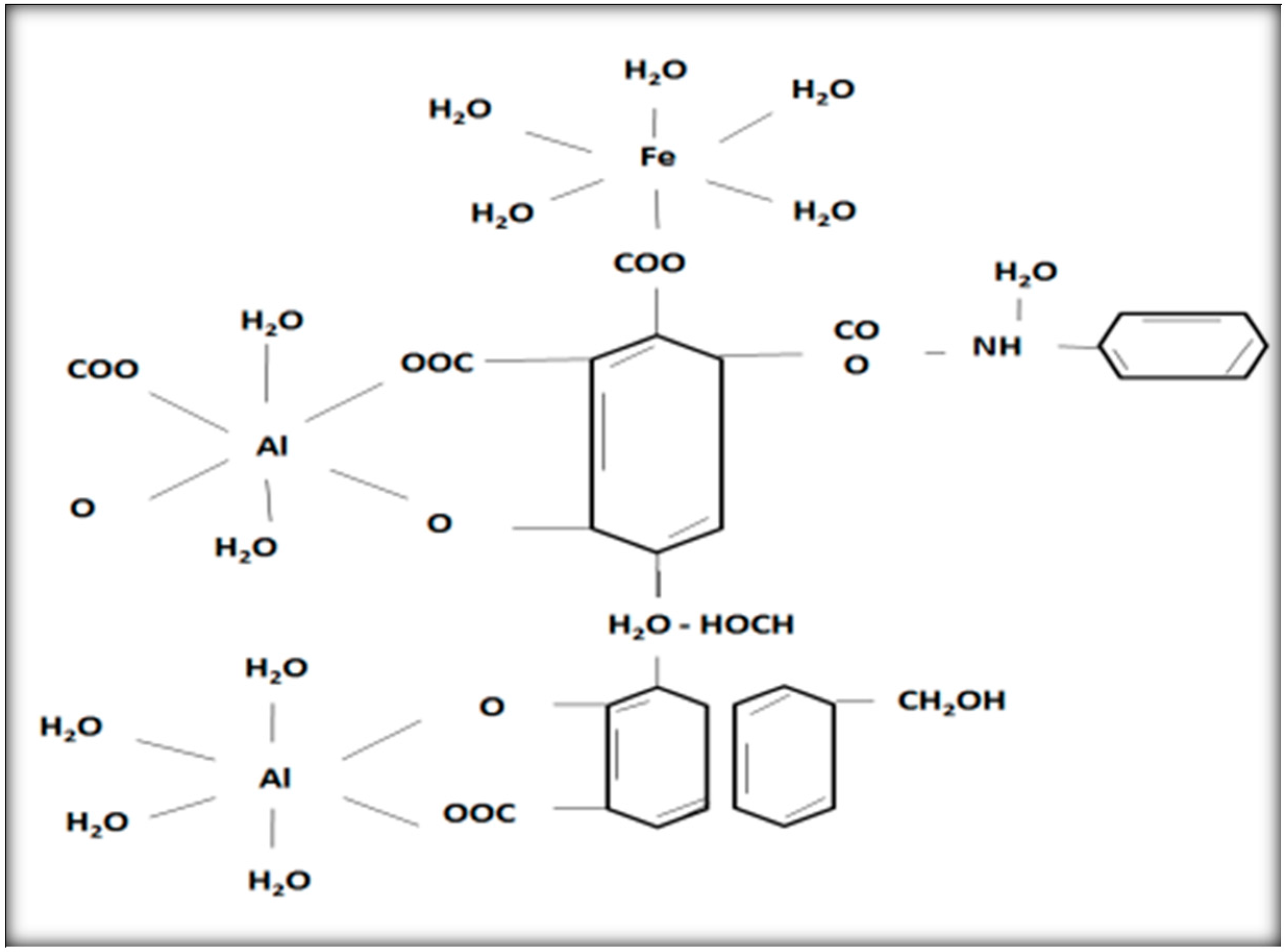
| Treatments | Soil pH at Harvest | |||
|---|---|---|---|---|
| Before Treatment | 1st Season | 2nd Season | 3rd Season | |
| Control | 3.78a | 3.91d | 3.86d | 3.85e |
| GML | 3.78a | 4.75b | 4.79b | 4.62d |
| Basalt | 3.78a | 4.49c | 5.07a | 4.88b |
| Bio-fertilizer | 3.78a | 4.17c | 4.14c | 4.11d |
| GML + bio-fertilizer | 3.78a | 5.27a | 5.12a | 4.85c |
| Basalt + bio-fertilizer | 3.78a | 4.32c | 5.29a | 5.15a |
| Treatments | Total N | Av. P | Exchangeable Cations | Micronutrients | ||||||
|---|---|---|---|---|---|---|---|---|---|---|
| K | Al | Ca | Mg | Fe | Zn | Mn | Cu | |||
| (%) | (mg·kg−1) | (cmolc kg−1) | (mg·kg−1) | |||||||
| Control | 0.11c | 18.64d | 0.14d | 5.03a | 0.65e | 0.7e | 189a | 1.70b | 6.13c | 1.87e |
| GML | 0.16b | 19.83c | 0.17c | 0.93c | 1.01d | 1.27d | 86c | 2.00a | 10.03a | 3.14c |
| Basalt | 0.20a | 20.16c | 0.26b | 0.86c | 2.14b | 2.12b | 79c | 2.16a | 9.87b | 3.84b |
| Bio-fertilizer | 0.21a | 29.23b | 0.24b | 1.85b | 0.96d | 1.18d | 141b | 2.10a | 8.21b | 2.03d |
| GML + bio-fertilizer | 0.22a | 33.74a | 0.31a | 0.78d | 2.25a | 2.98a | 67d | 2.03a | 10.71a | 4.12a |
| Basalt + bio-fertilizer | 0.20a | 30.26ab | 0.29a | 0.69d | 1.13c | 1.68c | 76c | 2.01a | 10.87a | 3.81b |
| Treatments | Chlorophyll Content (SPAD Values) | ||
|---|---|---|---|
| 1st Season | 2nd Season | 3rd Season | |
| (after 90 days of sowing) | |||
| Control | 34.53d | 36.2d | 33.90d |
| GML | 41.73b | 43.60b | 41.50c |
| Basalt | 40.27c | 42.60c | 43.60b |
| Bio-fertilizer | 42.30a | 42.70c | 41.3c |
| GML + bio-fertilizer | 42.33a | 45.50a | 44.40a |
| Basalt + bio-fertilizer | 41.43b | 44.20b | 44.90a |
| Treatments | Plant Height | Root Length | Tillers Plant−1 | ||||||
|---|---|---|---|---|---|---|---|---|---|
| (cm) | |||||||||
| 1st Season | 2nd Season | 3rd Season | 1st Season | 2nd Season | 3rd Season | 1st Season | 2nd Season | 3rd Season | |
| Control | 89d | 75.33d | 70.36e | 19.66d | 17.52e | 16.30d | 9c | 14c | 26d |
| GML | 96.41c | 83.13b | 78.15c | 21.34b | 20.67d | 19.00c | 19a | 16b | 30b |
| Basalt | 95.31c | 81.67c | 76.67d | 20.13c | 22.53b | 21.12b | 16b | 16b | 30b |
| Bio-fertilizer | 99.33b | 81.00c | 76.03d | 21.46b | 21.33c | 20.00c | 20a | 15b | 29c |
| GML + bio-fertilizer | 104.00a | 86.54a | 81.33a | 23.65a | 24.41a | 23.31a | 21a | 18a | 31a |
| Basalt + bio-fertilizer | 99.33b | 85.34a | 80.23b | 22.30b | 23.04a | 22.32a | 19a | 17a | 31a |
| Treatments | Number of Panicle Plant−1 | Size Panicle−1 | Unfilled Grains (%) | Harvest Index | ||||||||
|---|---|---|---|---|---|---|---|---|---|---|---|---|
| 1st Season | 2nd Season | 3rd Season | 1st Season | 2nd Season | 3rd Season | 1st Season | 2nd Season | 3rd Season | 1st Season | 2nd Season | 3rd Season | |
| Control | 7c | 11d | 22e | 17.83e | 17.67c | 17.39d | 26.21a | 24.69a | 23.77a | 0.40e | 0.41d | 0.46d |
| GML | 15a | 13b | 26c | 22.60b | 20.00b | 20.00b | 18.31d | 19.46c | 18.92c | 0.45b | 0.50c | 0.49c |
| Basalt | 16a | 13b | 27b | 18.33d | 19.87b | 20.11ab | 20.45b | 21.59c | 19.29c | 0.41c | 0.51b | 0.49c |
| Bio-fertilizer | 14b | 12c | 25d | 20.10c | 19.52b | 19.67c | 16.12f | 22.97b | 20.38b | 0.35d | 0.51b | 0.49c |
| GML + bio-fertilizer | 15a | 16a | 28a | 24.23a | 21.71a | 21.65a | 17.82e | 15.76d | 13.89d | 0.55a | 0.53a | 0.53a |
| Basalt + bio-fertilizer | 15a | 15a | 27b | 23.00b | 21.16a | 21.37a | 19.24c | 15.28d | 14.13d | 0.47b | 0.52b | 0.50b |
| Treatments | N | P | K | Protein Content in Grain | |||
|---|---|---|---|---|---|---|---|
| Plant | Grain | Plant | Grain | Plant | Grain | ||
| (%) | |||||||
| Control | 0.46c | 0.93c | 0.12c | 0.15c | 1.31c | 0.22d | 5.53c |
| GML | 0.66b | 0.98b | 0.15a | 0.28b | 1.48b | 0.28b | 5.83b |
| Basalt | 0.68a | 0.97b | 0.16a | 0.29b | 1.49b | 0.28b | 5.77b |
| Bio-fertilizer | 0.67b | 0.97b | 0.14b | 0.27b | 1.45b | 0.25c | 5.77b |
| GML + bio-fertilizer | 0.71a | 1.06a | 0.17a | 0.33a | 1.54a | 0.31a | 6.30a |
| Basalt + bio-fertilizer | 0.70a | 1.03a | 0.17a | 0.32a | 1.56a | 0.32a | 6.12a |
| Treatments | Metal Concentration in the Plant | ||||
|---|---|---|---|---|---|
| Al | Fe | Ca | Mg | Si | |
| (%) | |||||
| Control | 0.05a | 0.11a | 0.08d | 0.29d | 0.15d |
| GML | 0.03b | 0.07b | 0.17b | 0.43b | 0.25c |
| Basalt | 0.02b | 0.09b | 0.14c | 0.47b | 0.53a |
| Bio-fertilizer | 0.03b | 0.09b | 0.13c | 0.35c | 0.28c |
| GML + bio-fertilizer | 0.02b | 0.05b | 0.23a | 0.62a | 0.49b |
| Basalt + bio-fertilizer | 0.02b | 0.06b | 0.24a | 0.56a | 0.56a |
© 2016 by the authors; licensee MDPI, Basel, Switzerland. This article is an open access article distributed under the terms and conditions of the Creative Commons Attribution (CC-BY) license (http://creativecommons.org/licenses/by/4.0/).
Share and Cite
Panhwar, Q.A.; Naher, U.A.; Shamshuddin, J.; Othman, R.; Ismail, M.R. Applying Limestone or Basalt in Combination with Bio-Fertilizer to Sustain Rice Production on an Acid Sulfate Soil in Malaysia. Sustainability 2016, 8, 700. https://doi.org/10.3390/su8070700
Panhwar QA, Naher UA, Shamshuddin J, Othman R, Ismail MR. Applying Limestone or Basalt in Combination with Bio-Fertilizer to Sustain Rice Production on an Acid Sulfate Soil in Malaysia. Sustainability. 2016; 8(7):700. https://doi.org/10.3390/su8070700
Chicago/Turabian StylePanhwar, Qurban Ali, Umme Aminun Naher, Jusop Shamshuddin, Radziah Othman, and Mohd Razi Ismail. 2016. "Applying Limestone or Basalt in Combination with Bio-Fertilizer to Sustain Rice Production on an Acid Sulfate Soil in Malaysia" Sustainability 8, no. 7: 700. https://doi.org/10.3390/su8070700
APA StylePanhwar, Q. A., Naher, U. A., Shamshuddin, J., Othman, R., & Ismail, M. R. (2016). Applying Limestone or Basalt in Combination with Bio-Fertilizer to Sustain Rice Production on an Acid Sulfate Soil in Malaysia. Sustainability, 8(7), 700. https://doi.org/10.3390/su8070700




